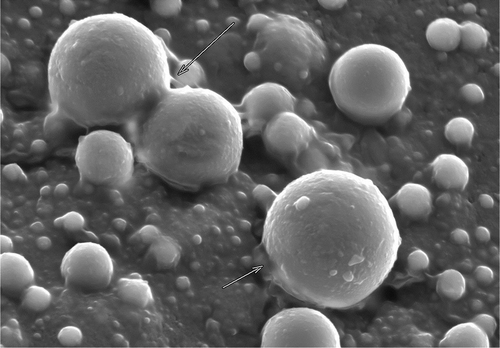ABSTRACT
The effect of aloe gel (AG) and vegetable oil (VO) as animal fat replacers on the texture, dynamic rheology, microstructure, and oxidative stability of low-fat meat emulsions was evaluated. There was no difference in complex viscosity (η*), G’0 - G’’0, and An values between 50% fat replacement and full-fat meat emulsion samples. In all the samples, the G′ values were much higher than G″ values with a small frequency dependency. In low-fat meat emulsion (50% fat replacement) samples, the difference between G’ and G’’ was higher which suggested strong matrix network structure. Hardness and springiness values were affected (P < 0.05) by addition of AG and were in agreement with dynamic rheological parameters (G’ and G’’). The scanning electron microscopic (SEM) images of meat emulsion samples containing 50% AG showed more regular, compact, and dense continuous phase as compared to other samples. Higher oxidative stability (low TBARs) was observed (P < 0.05) in samples which contained AG.
Introduction
Meat and meat products are good source of essential nutrients with high biological value. The high fat content in processed meat products is responsible for desired eating and sensory attributes[Citation1] which are important for consumer acceptability. However, these products are often considered as unhealthy by consumers due to the presence of high saturated fat. The high consumption of saturated fat is positively correlated with the higher incidence of cardiovascular diseases and other physiological disorders.[Citation2] Thus, the development of low-fat meat products with desired attributes as possessed by full-fat meat products is a challenge for the meat industry. Keeping this in view, some fat replacers (plant proteins, polysaccharides, extracts, fibres, vegetable oil, gums, etc.) have been identified and used for manufacture of low-fat meat products.
Low-fat meat products have been developed using some non-meat ingredients or plant oils (replacement of highly saturated animal fat) like inulin and bovine plasma proteins[Citation3]; pineapple by-product and canola oil[Citation4]; rice bran oil and malva nut gum[Citation5]; grape seed oil and rice bran fibre[Citation6]; sugarcane dietary fibre and pre-emulsified sesame oil[Citation7]; fish oil, milk proteins, and carrageenan.[Citation8] However, the addition of non-meat ingredient and/or the substitution of animal fat with plant oil alter the technological properties of meat emulsion. Therefore, the most important factor for manufacture of low-fat meat products is to avoid the undesirable quality changes, notably emulsion stability and rheology of the meat products.[Citation9]
Aloe plant (Aloe barbadensis miller; Liliaceae) contains aloe gel (AG) in its leafy structures. The importance of aloe-based drugs has been reviewed recently.[Citation10] Various polysaccharides like mannans, arabinans, and arabinogalactans are found in the AG which are associated with moisture retention capacity, formation of gel structure inside the leaf structures, and other biological activities.[Citation11–Citation13] The AG can be used for development of various food products without greatly affecting the colour and flavour properties because of its colourless, odourless, and tasteless behaviour. In our previous study, it was demonstrated that the addition of AG in the meat emulsion resulted in higher or at least similar physico-chemical, technological, and sensory properties of low-fat meat products.[Citation14] Recently, Soltanizadeh and Ghiasi-Esfahani[Citation15] concluded that aloe vera acted as a hydrocolloid and improved the quality of low-meat beef burgers in terms of physicochemical and technological properties. However, the effects of addition of AG have not been studied on the rheological properties, textural attributes, microstructural relationship with dynamic rheological attributes, and oxidative stability of low-fat meat emulsion. The objective of this study was therefore to assess the impact of addition of AG in combination with vegetable oil (VO) in various proportions on dynamic rheology, texture profile, microscopic structure, and oxidative stability of low-fat meat emulsions.
Materials and methods
Materials
Fresh broiler chicken meat (6 weeks of age) from breast and thigh region (1:1) was purchased from a local meat market. All visible fat and connective tissue were trimmed off, and the meat was stored at 0°C until it is required for product manufacture. Suitable amount of the meat was partially thawed at 4°C prior to meat emulsion preparation. As fat source, commercial soybean oil (Fortune, Adani Wilmar Limited, Gujarat, India) (16% saturated fatty acid, SFAs; 24% monounsaturated fatty acid, MUFAs; and 60% polyunsaturated fatty acid, PUFAs) was used.
AG was obtained from leaves of Aloe (Aloe barbadensis miller) plant grown locally (approximately 3 years of age). The pulp contents were obtained manually as described by Kumar, et al.[Citation14] Heat treatment (65°C for 10 min) was applied to the homogenised AG for improving its functional properties and for protecting its biological activity during further processing and storage.[Citation16] AG was then cooled and stored at 4 ± 1°C until it is used for product manufacture. AG was taken fresh from different representative areas and was processed in these similar conditions during various repetition and replication of experiments. The physical properties (rheological) and chemical composition (carbohydrates/monosaccharide/polysaccharide/protein/acetyl) of AG from Aloe barbadensis miller have been characterised in previous studies.[Citation17–Citation18] The analysed pH of this AG was 4.31 ± 0.02.
Experimental design and manufacture of low-fat meat emulsion
The emulsion was prepared as described by Choi et al.[Citation19] Four different formulations of low-fat meat emulsion including control were manufactured according to in triplicate (three trials each). The meat was passed through a meat mincer (Sirman, Pieve di Curtarolo, PD, Italy) with a 5 mm hole plate, mixed well by hands, and divided in four equal parts. Each portion was homogenised and ground for 1 min in a meat cutter (Scharfen, Germany). NaCl (2%) was added to meat that had been previously dissolved in chilled water (2°C) and then mixed for 1 min in the same meat cutter. AG and VO were added to the samples according to the formulations, and the emulsion samples were homogenised for 3 min. The final emulsion temperature was below 12°C in all cases. The samples were analysed for various properties, either as raw or after steam cooking at 120°C for 20 min. For steam cooking, the raw emulsion samples were filled in the rectangular aluminium boxes of 10 cm × 20 cm dimensions. The different samples served as: 100% AG (AGT1), 100% fat (VOT2; Positive control), 50% fat replaced (AGVOT3), without any AG or fat (CT4; negative control for comparison with other three samples). Samples were filled in LDPE and stored at 4°C for storage studies.
Table 1. Formulation (g) of meat emulsions containing aloe gel (AG) and the vegetable oil (VO) in different proportions.
Dynamic viscoelastic characterisation
Rheological measurements were performed on a rheometer (MCR 101, Anton Paar GmbH, Graz, Austria) fitted with 50 mm smooth parallel plate (PP50-SN23970; d=1 mm) geometry running Rheoplus software package (RHEOPLUS/32 V3.40 21005317-33024, Anton Paar GmbH, Germany). Raw meat emulsion was placed onto the centre of the base plate. The upper plate was moved into position, that is, the distance between the two plates (gap) was set to 1 mm. Excess material was trimmed from the plate edges, and samples were allowed to rest for appropriate time duration to achieve a constant test temperature (25°C regulated by the rheometer’s Pelltier plate and temperature hood) and for relaxation of residual stresses. Viscoelastic properties were assessed by performing a preliminary amplitude sweep to identify the linear viscoelastic (LVE) region of the samples. A frequency sweep from 0.1 to 100 Hz was performed, and the results for storage modulus (G’), loss modulus (G’’), and complex viscosity (η*) were recorded. The complex dynamic viscosity (η*) (Pa.s) is used to describe the total resistance of a material considered to be a viscous liquid.[Citation20] This is an indicator of the overall response of samples against the sinusoidal strain calculated by the following equations[Citation21]:
Loss tangent (tan δ) was calculated according to the following equation which denotes relative effects of viscous and elastic components in a viscoelastic behaviour.
The rheological moduli (G’ and G’’) were modelled using the following power law equations (Friedrich and Heymann 1988):
Instrumental texture profile analysis
Texture profile analysis (TPA) was performed in a TA-HDi Texture Analyzer (Stable Micro Systems LTD., UK), and attributes were calculated as described by Bourne.[Citation22] Three determinations per formulation of cooked (120°C for 20 min) meat emulsion (2.5 × 2.5 × 2.5 cm) were compressed to 40% of their original height. Force–time deformation curves were derived with a 50 kg load cell applied at a constant crosshead speed of 1 mm/s. Attributes were calculated as hardness (Hd): peak force (N) required for first compression; cohesiveness (Ch): ratio of active work did under the second compression curve to that did under the first compression curve (dimensionless); springiness (Sp): distance (mm) of sample recovery after the first compression; and chewiness: Hd × Ch × Sp (N mm). All texture measurements were carried out at room temperature. Texture measurement was done for freshly cooked samples as well as for stored samples from day zero to day eight to see the effect of refrigerated storage conditions on the textural attributes of various emulsion samples.
Microstructure
Microstructure of fresh raw meat emulsion samples was analysed by scanning electron microscopy (SEM) as described by Kumar et al.[Citation14] The meat emulsion samples were fixed with a mixture of 2.5% glutaraldehyde (2.5 g/100 g) in 0.1 M sodium cacodylate buffer (pH 7.2), post fixed with OsO4, washed, dehydrated in increasing concentrations of alcohol, critical-point-dried, sputter coated with gold in a ion sputter coater (Hitachi, E1010), and scanned by SEM (S-3400N; Hitachi, Tokyo, Japan) at 15 kV. A large number of micrographs were taken to select the most representative ones.
Estimation of oxidative stability
The thiobarbituric acid reactive substances (TBARS) were determined from day zero to day eight by using the extraction method[Citation23] to analyse the effect of AG addition on the oxidative stability of meat emulsion samples. Samples (4 g) were homogenised with 20 ml trichloro acetic acid solution (20%), and the slurry was centrifuged (3000 g) (MP 400R Eltek Ltd., India) for 10 min. The supernatants (2 ml) were mixed with equal volume of freshly prepared 0.1% thiobarbituric acid (TBA) in glass test tubes and heated in water bath at 100°C for 30 min followed by cooling under tap water. The absorbance of the mixtures was measured at 532 nm, and the TBARS values were calculated using a standard curve and expressed in mg malonaldehyde/kg.
Statistical analysis
All data were summarised and submitted to one-way analysis of variance (ANOVA). Tukey’s test (P < 0.05) was applied to determine significant differences between treatments.
Results and discussion
Dynamic viscoelastic characterisation
The results of strain sweep test showed that the storage modulus (G’) and loss modulus (G’’) values were almost independent of the stress-strain within the linear viscoelastic region (LVR), and a further increase in applied stress resulted in a sudden fall of the G′ values which might be due to the rupturing of myofibrillar protein–protein interactions (Tabilo-Munizaga & Barbosa-Cánovas, 2005). The samples containing vegetable oil (VOT2) and aloe gel+vegetable oil (AGVOT3) were able to withstand a higher stress before rupturing than AGT1 and CT4 samples. The G’ was higher than G” in the LVR region in all the samples, which indicated that the samples were more elastic than viscous with a network structure[Citation24] because the G′ reflects solid-like properties of a viscoelastic material, while the G″ reflects liquid-like properties.
In the frequency sweep test (), the G′ values were much higher than G″ values over all experimental ω values with a small frequency dependency in all the samples. Thus, all the samples showed typical viscoelastic behaviour with typical ‘weak gel’ properties. This type of behaviour is usually shown by a 3D gel cross-linked gel network.[Citation25] Similar results were obtained for low-lipid meat emulsions containing fish oil and different binders,[Citation26] emulsified sausages with added carboxymethyl cellulose and microcrystalline cellulose,[Citation27] and low-fat sausage containing inulin,[Citation28] as a fat substitute. Same proportional changes in the G′ and G″ values with frequency over a wide range were seen () in the AGVOT3 samples which also suggested that these samples had well organised matrix structure[Citation29] which provided more stability to the emulsion samples.
Figure 1. Frequency sweep test for mechanical spectra: storage modulus (G′), loss modulus (G″), and complex viscosity (η*) of different meat emulsion samples at 25°C. For sample denomination, see .
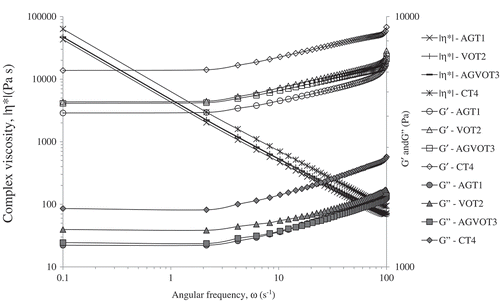
In general, G’ and G’’ decreased with the increase of AG addition which could be associated with the increase in the moisture contents (improved WHC)[Citation14] and the viscous effect of the AG itself. A decrease in storage and loss moduli with increasing hydrocolloid concentration though no changes in loss tangent was also observed for various meat products.[Citation27] The AGVOT3 samples showed higher G′ at lower frequency, bigger difference between G′ and G′′, and a smaller slope of the curve () as compared to AGT1 samples where the initial G′ values were lower. The G’ values for the AGVOT3 and VOT2 samples were non-significant but higher (P < 0.05) than those for the AGT1 samples. Moreover, the difference between G’ and G’’ was lesser in VOT2 samples as compared to the AGVOT3 samples. The CT4 samples showed higher G’ at lower frequency, but the difference between G’ and G’’ was lesser than the AGVO3 samples. This indicated that the AGVOT3 samples had the strongest network structure as compared to the other samples. The tan δ values were nonsignificant among AGT1, VOT2, and CT4 samples but significantly more in AGVOT3 samples. Moreover, the higher tan δ values () in AGVOT3 samples showed that combination of AG and VO resulted in more stable matrix than only AG-containing or only VO-containing samples.
Table 2. Loss tangent (tan δ) and power law parameters (fitted values) for the rheological parameters from frequency sweep test, at 25°C for different samples.
The viscoelastic parameters as obtained by fitting power law equations are presented in . The difference between G’0 and G’’0 as well as the value of An suggests strength of viscoelastic material and rheological unit interaction. These parameters have been used to assess the firmness of gel matrix.[Citation30] G’0 - G’’0 and An values were highest in the CT4 samples, lowest in AGT1 samples, and in VOT2 and AGVOT3 samples values were intermediate. Values were somewhat similar (lesser difference) in VOT2 and AGVOT3 samples. This suggested that samples with 100% AG were least rigid and firmer than other samples. The properties of AGVOT3 and VOT2 samples were similar in terms of rigidness and firmness. This suggested that replacement of VO with AG had minimal effect on these parameters. It has also been suggested by Delgado-Pando et al.[Citation30] that lower values of G’0 - G’’0 and An resulted in better binding properties, and higher values resulted in poor gel quality due to low emulsion stability. In our previous study,[Citation14] it was observed that emulsion samples containing AG showed more emulsion stability and binding properties, and thus results of rheological parameters in present study (G’0 - G’’0 and An) are consistent with this fact that increase in the value of G’0 - G’’0 and An resulted in lower emulsion stability (gel quality) parameters.
All the emulsion samples showed similar flow characteristic ( and ), that is, shear-thinning behaviour in accordance with the power law model. This shear thinning region might occur as a result of structural breakdown due to oil droplet deflocculation.[Citation31] The complex viscosity of AGT1, VOT2, and AGVOT3 was lower than that of the CT4; however, complex viscosity was non-significant (P < 0.05) between VOT2 and AGVOT3, which suggested no alteration in the viscosity component of AG-added low-fat meat emulsion samples.
Figure 2. Viscosity as a function of shear rate for different meat emulsion samples at 25°C. For sample denomination, see .
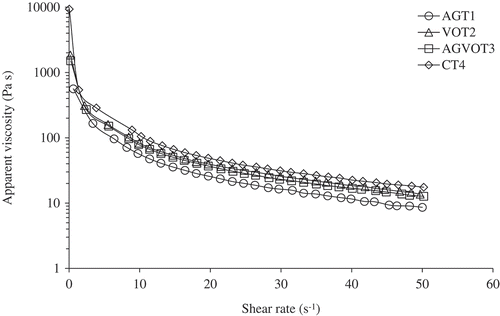
In the present study, the slopes were positive and almost parallel to each other. The curves were almost qualitatively similar for all the emulsion samples studied at low frequency levels, but slight deviation was observed at high frequency levels (). The magnitudes of G’ were always greater than those of G’’ without exhibiting no cross-point of G’ and G’’. This is a characteristic feature of weak gels and highly concentrated dispersions.[Citation32] The tan δ values at all the frequency were lower than one, which also suggested that the samples were more elastic rather than viscous. Moreover, the lower tan δ values during frequency sweep is also indicative of well-organised gel network.[Citation33] In general, this is a characteristic behaviour of protein-stabilised emulsions because an elastic network occurs due to the occurrence of an extensive bridging flocculation process.[Citation34] Chattong and Apichartsrangkoon[Citation35] stated that weak viscoelastic or coagulant gel types with some crosslink density showed this type of behaviour during rheological assessment.
Rivas and Sherman[Citation36] indicated that water-soluble meat proteins exhibited important viscoelasticity, which was attributed to the strong interlinking of water-soluble meat protein loops adsorbed on the surface of adjacent oil drops (, SEM image). Our frequency sweep measurement results were also consistent with the results of Flores et al.[Citation37] who studied pork meat emulsions containing sodium stearoyl-2-lactylate and carrageenan and reported that the meat emulsion samples exhibited solid-like mechanical spectra in which the storage modulus was much larger than the loss modulus in the frequency range of 1–100 rad/s. It was also reported by Flores et al.[Citation37] that meat emulsion containing sodium stearoyl-2-lactylate and carrageenan behaved as weak gel.
Figure 3. Scanning electron microscopic (SEM) images of full-fat meat emulsion (VOT2) samples: (a) at 500×, (b) at 1000×.
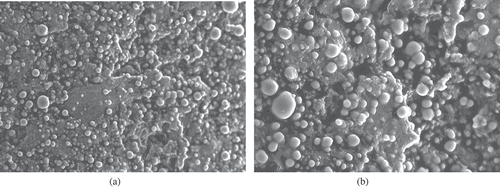
G’ and G’’ are related to the strength of intermolecular interactions of the emulsions and protein gel matrix while rate of change of these parameters is related to the stability of the matrix. The difference of G’ and G’’ is related with the strength of matrix. In the present study, this difference was larger in AGVOT3 samples which showed stronger intermolecular interactions and a more stable matrix. The addition of AG with the salt extracted meat protein might intensify the network of meat proteins and hence produced a uniform meat matrix with improved structural strength and stability. These results were similar to those of other food hydrocolloids, such as starch, konjac glucomannan, and hydroxypropyl methylcellulose mixed with SSP in restructured seafood.[Citation38–Citation39]
Texture profile analysis
The different attributes of texture profile of different meat emulsion samples are presented in . The hardness values at day zero differed significantly (P < 0.05) among different samples, and it was observed highest in the control samples. Thus, incorporation of AG in the meat emulsion formulation had resulted in the reduction of hardness values. This was in agreement with dynamic rheological values (G’ and G’’) which also suggested less elastic behaviour of meat emulsion samples containing AG as compared to the other samples. The addition of AG with VO also resulted in lower chewiness values (P < 0.05) than control samples. However, chewiness at day zero was non-significant between AGT1, VOT2, and AGVOT3 samples. The values for chewiness increased gradually from day zero to day eight in all samples irrespective of treatment. The increment in chewiness values was observed more in AG-treated samples. Somewhat similar trends were observed for gumminess values at day zero and subsequent storage period.
Table 3. Effect of aloe gel (AG) addition on textural attributes (texture profile analysis, TPA) of cooked meat emulsion during refrigerated storage (mean ± SD) (n = 9).
Similar hardness and chewiness trends were observed for low-fat salami containing rice bran oil and malva nut gum[Citation5]; for meat emulsion containing sodium stearoyl-2-lactylate and carrageenan[Citation37]; and for frankfurters containing canola-olive oil, rice bran, and walnut.[Citation40] The softening of the product’s texture was also observed when plant oil was used for manufacturing of low-fat meat products.[Citation41]
Marchetti et al.[Citation26] used various binders with fish oil to formulate low-fat meat emulsions, and they concluded that fish oil reduced around 40.2% of hardness than the control samples. Addition of fish oil resulted in lower hardness value in these experiments. In our previous experiments,[Citation14] it was concluded that AG addition resulted in more water binding and fat binding properties of low-fat meat emulsion. This might be the reason behind lower hardness and chewiness values of meat emulsion samples containing AG. During storage period, the hardness values increased in all groups, and the increase was observed more in AG-treated samples. This might be due to more water content (more evapouration and dryness during storage) in the AG-containing samples because of high water holding capacity.[Citation14]
The springiness values also differed significantly (P < 0.05) among different samples initially. Lowest springiness values were obtained for control samples. No definite trend was observed during storage period for springiness values. In most instances, springiness values did not change (P < 0.05) during whole storage period in any of the samples. The cohesiveness values at day zero and day two did not differ significantly (P < 0.05). The cohesiveness gradually increased during storage period in all the treatments and differed significantly.
Microstructure
The scanning electron microscopic (SEM) images of the full-fat (VOT2) and low-fat raw meat emulsion (AGVOT3) at different magnifications are shown in and , and and , respectively. The microstructure of VOT2 showed more cracks with oil droplets of irregular shapes and size in comparison with AGVOT3 samples. The AGVOT3 samples showed more regular, compact, and dense continuous phase as compared to VOT2 samples.
Figure 4. Scanning electron microscopic (SEM) images of low-fat meat emulsion (AGVOT3; 50% fat replacement) samples: (a) at 500×, (b) at 1000×.
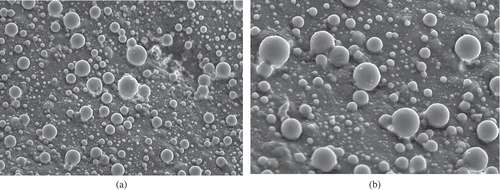
Addition of AG had provided more stability[Citation14] to the salt extracted meat proteins which might be the cause for a homogenous network in AGVOT3 samples. The results of textural properties were also in agreement with the properties of SEM micrographs and with the dynamic rheological properties of different emulsion samples. This could be attributed to the reaction between AG polysaccharides and muscle protein–water phase.
Similarly, Jiménez-Colmenero et al.[Citation42] studied pork fat replacement with an emulsified olive oil in frankfurters and found smaller cavities and a firmer network than the control samples. Jiménez-Colmenero et al.[Citation43] also described changes in the structure of reduced-fat frankfurter when KG was added in the formulations. Similar findings on the microstructure have also been reported by Salcedo-Sandoval et al. (2013) when some fat replacers have been used during manufacturing of low-fat meat products.
The formation, properties, and stability of meat emulsion depend predominantly on protein and the presence of other non-meat ingredients in the mixture. Moreover, efficient formation of fat globules is a prerequisite for well-stabilised emulsion structure.[Citation44] In the present study, microstructural images revealed that AG-VO-fat globules reduced the porosity and significantly increased the stability of emulsion which suggested that AG might enhance the emulsifying ability of meat proteins. In most of the previous studies, the fat of animal origin or combinations of animal and vegetable fat were used. It is well established that the type of fat affects the distribution of fat and influences the meat emulsion stability. Substitution of animal fat (high melting point) with vegetable oil (low melting point) facilitates uniform distribution of oil droplets in meat emulsion which leads to more stabilised and homogeneous protein–water–fat matrix. In the present study, the AG and VO combination improved the emulsifying ability of meat proteins as well as stabilised oil droplets more efficiently which might be due to the formation of thin protein film around the fat droplets () or by establishing some other adhesion forces (previous section results; G’ and G’’) between protein, water, and fat molecules ().
Oxidative stability
Nature of the product, type of muscles, amount and type of fats, and the presence of antioxidants affect the overall oxidative stability of meat products. TBARs estimation is the method which suggests the stability of a food system against oxidation chain reactions.[Citation45] The changes in the TBARs values of different samples during eight-day refrigerated storage period are shown in . TBARS values were significantly affected (P < 0.05) by ingredient combination and storage duration. In general, the higher oxidative stability was observed (low TBARs) (P < 0.05) in samples containing AG. VOT2 samples showed highest TBARs value. This might be due to more fat content of VOT2 samples. Similarly, Estévez et al.[Citation46] reported significantly higher levels of TBARs in high-fat meat products. The presence of antioxidants in AG[Citation47] might be another reason behind lesser TBARs value in samples containing AG. Likewise, konjac addition in the reformulated meat products also led to lower TBARS values when added to total pork back fat replacement samples.[Citation48]
Figure 6. TBARs (mg malonaldehyde/kg) values of different meat emulsion samples during refrigerated (4 ± 1°C) storage (n = 9). For sample denomination, see .
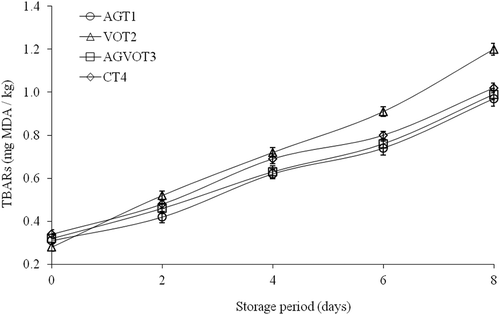
The vegetable (plant) oil contains more mono and polyunsaturated fatty acids as compared to animal fat (more saturated fatty acids). The polyunsaturated fatty acids are more prone to oxidative damage due to the presence of less stable multiple bonds.[Citation48] These bonds are easily attacked by some pro-oxidants and reactive oxygen species. This favours the oxidative chain reactions to occur. More TBARs in VOT2 samples in present study were due to this reason. In the earlier studies, it was confirmed that meat products containing plant oil or more unsaturated fatty acids had lesser oxidative stability.[Citation4,Citation49]
Conclusion
The effect of aloe gel on the rheological parameters of meat emulsion was evaluated. The addition of AG in the meat emulsion formulation improved the emulsifying ability of meat proteins and resulted in more uniform emulsion matrix than other samples as suggested by the mechanical spectra, SEM, textural studies, and modelling of rheological parameters according to the power law equations. Addition of aloe gel also resulted in higher oxidative stability of low-fat meat emulsion samples. Thus, low-fat meat products may be made with the addition of aloe gel during manufacturing of emulsion-type meat products.
Funding
The authors would like to extend thanks to Indian Council of Agricultural Research, India for financial support to this research project (Grant number: IXX12120, Institute Project).
Additional information
Funding
References
- Choi, Y.-S.; Park, K.-S.; Kim, H.-W.; Hwang, K.-E.; Song, D.-H.; Choi, M.-S.; Lee, S.-Y.; Paik, H.-D.; Kim, C.-J. Quality Characteristics of Reduced-Fat Frankfurters with Pork Fat Replaced by Sunflower Seed Oils and Dietary Fiber Extracted from Makgeolli Lees. Meat Science 2013, 93(3), 652–658.
- Ospina-E, J.C.; Sierra-C, A.; Ochoa, O.; Pérez-Álvarez, J.A.; Fernández-López, J. Substitution of Saturated Fat in Processed Meat Products: A Review. Critical Reviews in Food Science and Nutrition 2012, 52(2), 113–122.
- Rodriguez-Furlán, L.T.; Padilla, A.P.; Campderrós, M.E. Development of Reduced Fat Minced Meats Using Inulin and Bovine Plasma Proteins as Fat Replacers. Meat Science 2014, 96( 2, Part A), 762–768.
- Selani, M.M.; Shirado, G.A.N.; Margiotta, G.B.; Rasera, M.L.; Marabesi, A.C.; Piedade, S.M.S.; Contreras-Castillo, C.J.; Canniatti-Brazaca, S.G. Pineapple By-product and Canola Oil as Partial Fat Replacers in Low-fat Beef Burger: Effects on Oxidative Stability, Cholesterol Content and Fatty Acid Profile. Meat Science 2016, 115, 9–15.
- Pramualkijja, T.; Pirak, T.; Kerdsup, P. Effect of Salt, Rice Bran Oil and Malva Nut Gum on Chemical, Physical and Physico–Chemical Properties of Beef Salt–Soluble Protein and Its Application in Low Fat Salami. Food Hydrocolloids 2016, 53, 303–310.
- Choi, Y.-S.; Choi, J.-H.; Han, D.-J.; Kim, H.-Y.; Lee, M.-A.; Kim, H.-W.; Lee, J.-W.; Chung, H.-J.; Kim, C.-J. Optimization of Replacing Pork Back Fat with Grape Seed Oil and Rice Bran Fiber for Reduced-fat Meat Emulsion Systems. Meat Science 2010, 84(1), 212–218.
- Zhuang, X.; Han, M.; Kang, Z.-l.; Wang, K.; Bai, Y.; Xu, X.-l.; Zhou, G.-h. Effects of the Sugarcane Dietary Fiber and Pre-emulsified Sesame Oil on Low-fat Meat Batter Physicochemical Property, Texture, and Microstructure. Meat Science 2016, 113, 107–115.
- Marchetti, L.; Andrés, S.C.; Califano, A.N. Low-fat Meat Sausages with Fish Oil: Optimization of Milk Proteins and Carrageenan Contents Using Response Surface Methodology. Meat Science 2014, 96(3), 1297–1303.
- Zorba, Ö.; Kurt, Ş. The Effects of Different Plant Oils on Some Emulsion Properties of Beef, Chicken and Turkey Meats. International Journal of Food Science and Technology 2008, 43(2), 229–236.
- Cirillo, C.; Capasso, R. Constipation and Botanical Medicines: An Overview. Phytotherapy Research 2015, 29(10), 1488–1493.
- Eshun, K.; He, Q. Aloe Vera: A Valuable Ingredient for the Food, Pharmaceutical and Cosmetic Industries: A Review. Critical Reviews in Food Science and Nutrition 2004, 44(2), 91–96.
- Surjushe, A.; Vasani, R.; Saple, D. Aloe Vera: A Short Review. 2008; Vol. 53, p 163–166.
- García-Segovia, P.; Mognetti, C.; Andrés-Bello, A.; Martínez-Monzó, J. Osmotic Dehydration of Aloe Vera (Aloe Barbadensis Miller). Journal of Food Engineering 2010, 97(2), 154–160.
- Kumar, Y.; Kairam, N.; Ahmad, T.; Yadav, D.N. Physico Chemical, Microstructural and Sensory Characteristics of Low-fat Meat Emulsion Containing Aloe Gel as Potential Fat Replacer. International Journal of Food Science and Technology 2016, 51(2), 309–316.
- Soltanizadeh, N.; Ghiasi-Esfahani, H. Qualitative Improvement of Low Meat Beef Burger Using Aloe Vera. Meat Science 2015, 99, 75–80.
- Rodríguez-González, V.M.; Femenia, A.; González-Laredo, R.F.; Rocha-Guzmán, N.E.; Gallegos-Infante, J.A.; Candelas-Cadillo, M.G.; Ramírez-Baca, P.; Simal, S.; Rosselló, C. Effects of Pasteurization on Bioactive Polysaccharide Acemannan and Cell Wall Polymers from Aloe Barbadensis Miller. Carbohydrate Polymers 2011, 86(4), 1675–1683.
- Campestrini, L.H.; Silveira, J.L.M.; Duarte, M.E.R.; Koop, H.S.; Noseda, M.D. Nmr and Rheological Study of Aloe Barbadensis Partially Acetylated Glucomannan. Carbohydrate Polymers 2013, 94(1), 511–519.
- Lad, V.N.; Murthy, Z.V.P. Rheology of Aloe Barbadensis Miller: A Naturally Available Material of High Therapeutic and Nutrient Value for Food Applications. Journal of Food Engineering 2013, 115(3), 279–284.
- Choi, Y.-S.; Choi, J.-H.; Han, D.-J.; Kim, H.-Y.; Lee, M.-A.; Kim, H.-W.; Jeong, J.-Y.; Kim, C.-J. Characteristics of Low-fat Meat Emulsion Systems with Pork Fat Replaced by Vegetable Oils and Rice Bran Fiber. Meat Science 2009, 82(2), 266–271.
- Dimitreli, G.; Thomareis, A.S. Effect of Chemical Composition on the Linear Viscoelastic Properties of Spreadable-type Processed Cheese. Journal of Food Engineering 2008, 84(3), 368–374.
- Karaman, S.; Yilmaz, M.T.; Dogan, M.; Yetim, H.; Kayacier, A. Dynamic Oscillatory Shear Properties of O/W Model System Meat Emulsions: Linear Viscoelastic Analysis for Effect of Temperature and Oil Concentration on Protein Network Formation. Journal of Food Engineering 2011, 107(2), 241–252.
- Bourne, M.C. Texture Profile Analysis. Food Technology 1978, 33 62–66.
- Yogesh, K.; Jha, S.N.; Yadav, D.N. Antioxidant Activities of Murraya Koenigii (L.) Spreng Berry Extract: Application in Refrigerated (4 ± 1°C) Stored Meat Homogenates. Agricultural Research 2012, 1(2), 183–189.
- Mezger, T.G. The Rheology Handbook: For Users of Rotational and Oscillatory Rheometers. Vincentz Network GmbH & Co KG, Hanover, Germany, 2006.
- Iglesias-Otero, M.A.; Borderías, J.; Tovar, C.A. Use of Konjac Glucomannan as Additive to Reinforce the Gels from Low-quality Squid Surimi. Journal of Food Engineering 2010, 101(3), 281–288.
- Marchetti, L.; Andrés, S.C.; Califano, A.N. Textural and Thermal Properties of Low-lipid Meat Emulsions Formulated with Fish Oil and Different Binders. LWT - Food Science and Technology 2013, 51(2), 514–523.
- Schuh, V.; Allard, K.; Herrmann, K.; Gibis, M.; Kohlus, R.; Weiss, J. Impact of Carboxymethyl Cellulose (Cmc) and Microcrystalline Cellulose (Mcc) on Functional Characteristics of Emulsified Sausages. Meat Science 2013, 93(2), 240–247.
- Keenan, D.F.; Auty, M.A.E.; Doran, L.; Kerry, J.P.; Hamill, R.M. Investigating the Influence of Inulin as a Fat Substitute in Comminuted Products Using Rheology, Calorimetric and Microscopy Techniques. Food Structure 2014, 2(1–2), 1–13.
- Park, J.W. Surimi Seafood. In Surimi and Surimi Seafood, 2nd Edn.; Park, J.W. Eds.; CRC Press: Boca Raton, FL, 2005; 375–433.
- Delgado-Pando, G.; Cofrades, S.; Ruiz-Capillas, C.; Triki, M.; Jiménez-Colmenero, F. Low-fat Pork Liver Pâtés Enriched with N-3 Pufa/Konjac Gel: Dynamic Rheological Properties and Technological Behaviour During Chill Storage. Meat Science 2012, 92(1), 44–52.
- Moros, J.E.; Franco, J.M.; Gallegos, C. Rheology of Spray-dried Egg Yolk-Stabilized Emulsions. International Journal of Food Science and Technology 2002, 37(3), 297–307.
- Ross-Murphy, S.B., Rheological Methods. In Physical Techniques for the Study of Food Biopolymers; Ross-Murphy, S.B.; Ed.; Springer US: Boston, MA, 1994; 343–392.
- Binsi, P.K.; Shamasundar, B.A.; Dileep, A.O.; Badii, F.; Howell, N.K. Rheological and Functional Properties of Gelatin from the Skin of Bigeye Snapper (Priacanthus Hamrur) Fish: Influence of Gelatin on the Gel-forming Ability of Fish Mince. Food Hydrocolloids 2009, 23(1), 132–145.
- Franco, J.M.; Raymundo, A.; Sousa, I.; Gallegos, C. Influence of Processing Variables on the Rheological and Textural Properties of Lupin Protein-stabilized Emulsions. Journal of Agricultural and Food Chemistry 1998, 46(8), 3109–3115.
- Chattong, U.; Apichartsrangkoon, A. Dynamic Viscoelastic Characterisation of Ostrich-Meat Yor (Thai Sausage) Following Pressure, Temperature and Holding Time Regimes. Meat Science 2009, 81(3), 426–432.
- Rivas, H.J.; Sherman, P. Soy and Meat Proteins as Food Emulsion Stabilizers 1. Viscoelastic Properties of Corn Oil-in-water Emulsions Incorporating Soy or Meat Proteins. Journal of Texture Studies 1983, 14(3), 251–265.
- Flores, M.; Giner, E.; Fiszman, S.M.; Salvador, A.; Flores, J. Effect of a New Emulsifier Containing Sodium Stearoyl-2-Lactylate and Carrageenan on the Functionality of Meat Emulsion Systems. Meat Science 2007, 76(1), 9–18.
- Chen, H.-H.; Ferng, L.-H.; Chen, S.-D.; Sun, W.-C.; Lee, Y.-C. Combination Model for the Spatial Partition of Surimi Protein and Hydroxylpropylmethylcellulose. Food Hydrocolloids 2005, 19(4), 761–768.
- Ramírez, J.A.; Uresti, R.M.; Velazquez, G.; Vázquez, M. Food Hydrocolloids as Additives to Improve the Mechanical and Functional Properties of Fish Products: A Review. Food Hydrocolloids 2011, 25(8), 1842–1852.
- Álvarez, D.; Xiong, Y.L.; Castillo, M.; Payne, F.A.; Garrido, M.D. Textural and Viscoelastic Properties of Pork Frankfurters Containing Canola–Olive Oils, Rice Bran, and Walnut. Meat Science 2012, 92(1), 8–15.
- Rodríguez-Carpena, J.G.; Morcuende, D.; Estévez, M. Avocado, Sunflower and Olive Oils as Replacers of Pork Back-fat in Burger Patties: Effect on Lipid Composition, Oxidative Stability and Quality Traits. Meat Science 2012, 90(1), 106–115.
- Jiménez-Colmenero, F.; Herrero, A.; Pintado, T.; Solas, M.T.; Ruiz-Capillas, C. Influence of Emulsified Olive Oil Stabilizing System Used for Pork Backfat Replacement in Frankfurters. Food Research International 2010, 43(8), 2068–2076.
- Jiménez-Colmenero, F.; Cofrades, S.; López-López, I.; Ruiz-Capillas, C.; Pintado, T.; Solas, M.T. Technological and Sensory Characteristics of Reduced/Low-fat, Low-salt Frankfurters as Affected by the Addition of Konjac and Seaweed. Meat Science 2010, 84(3), 356–363.
- Steen, L.; Fraeye, I.; De Mey, E.; Goemaere, O.; Paelinck, H.; Foubert, I. Effect of Salt and Liver/Fat Ratio on Viscoelastic Properties of Liver Paste and Its Intermediates. Food and Bioprocess Technology 2014, 7(2), 496–505.
- Kumar, Y.; Yadav, D.N.; Ahmad, T.; Narsaiah, K. Recent Trends in the Use of Natural Antioxidants for Meat and Meat Products. Comprehensive Reviews in Food Science and Food Safety 2015, 14(6), 796–812.
- Estévez, M.; Ventanas, S.; Cava, R. Physicochemical Properties and Oxidative Stability of Liver Pâté as Affected by Fat Content. Food Chemistry 2005, 92(3), 449–457.
- Kumar, Y.; Langoo, B.A. Effects of Aloe, Green Tea, and Amla Extracts on Microbiological and Oxidative Parameters of Refrigerated Raw Meat Batter. Agricultural Research 2016, 5(1), 81–88.
- Delgado-Pando, G.; Cofrades, S.; Ruiz-Capillas, C.; Triki, M.; Jiménez-Colmenero, F. Enriched N − 3 Pufa/Konjac Gel Low-fat Pork Liver Pâté: Lipid Oxidation, Microbiological Properties and Biogenic Amine Formation During Chilling Storage. Meat Science 2012, 92(4), 762–767.
- Delgado-Pando, G.; Cofrades, S.; Ruiz-Capillas, C.; Solas, M.T.; Triki, M.; Jiménez-Colmenero, F. Low-fat Frankfurters Formulated with a Healthier Lipid Combination as Functional Ingredient: Microstructure, Lipid Oxidation, Nitrite Content, Microbiological Changes and Biogenic Amine Formation. Meat Science 2011, 89(1), 65–71.

